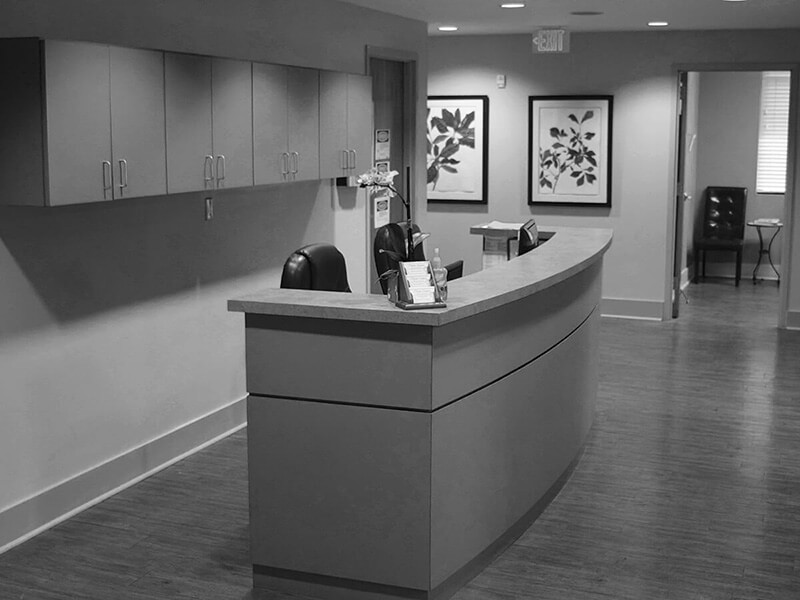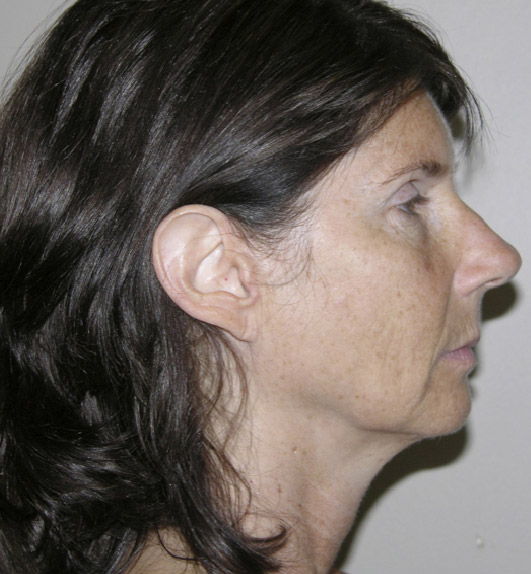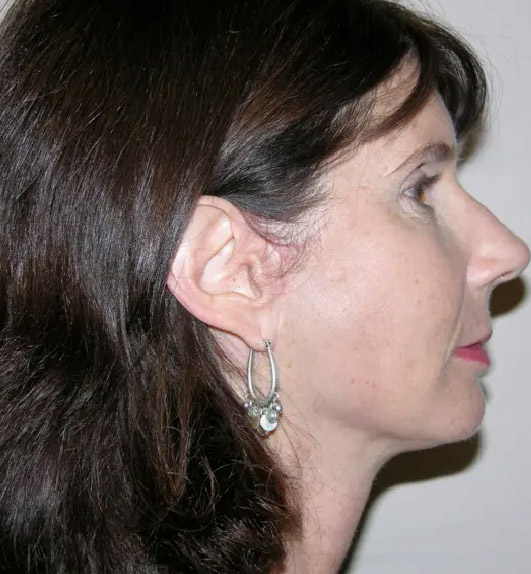Facelift surgery reverses the most noticeable signs of aging in the lower and middle regions of the face by trimming excess skin and tightening the underlying facial tissues.
As much as we’d like to believe that growing older is avoidable, our facial features tend to be the first indicator to show that we are, in fact, aging. Even if we still feel youthful and vibrant, outside appearances can contrast the vitality we feel inside. Over time, our skin and tissues naturally lose their elasticity, which leads to deep wrinkles and sagging skin on the face and neck. Facelift surgery, or rhytidectomy, can take years off your appearance by removing excess skin and smoothing out folds and wrinkles.
What Is Facelift Surgery?
Facelift surgery, also called rhytidectomy, is designed to lift, firm, and reposition sagging facial tissue in the lower two-thirds of your face to give you a more youthful appearance. Facelift surgery can erase deep folds and creases in your skin, eliminate excess drooping skin, lift and tighten facial muscles, and reposition fat to restore volume in your mid-face. When performed by a trained and experienced surgeon, a facelift leaves you looking like yourself—but fresher and younger.
What Are the Benefits of Facelift Surgery?
Facelift surgery is designed to address visible signs of aging on your face. Some of the benefits of facelift surgery include:
- – Lifting and tightening of the skin on your face
- – Removal of excess fat and a double chin
- – Fewer wrinkles and fine lines
- – Elimination of deep creases in your mid and lower face
- – A more defined jawline and removal of jowls
- – A smoother, re-contoured neck

What Can A Facelift Address?
Deep Facial Wrinkles
Collagen and elastin are the structural building blocks of our skin. As we age, our body naturally produces less of these proteins, which can cause deep wrinkles to form and facial tissues to sag. Facelift surgery trims excess skin and repositions the underlying fat and muscle to reduce the appearance of wrinkles.
Sagging in the Face and Neck
When our skin begins to sag, we appear permanently tired and prematurely aged. Sagging of the face and neck also alters the shape of your face by distorting angles, such as an alluringly chiseled jawline. Facelift surgery tightens the skin, muscles, and deep tissues to restore a natural, more youthful contour.
Facial Volume Loss
As you age, the once plump facial fat in your cheeks and under the eyes begins to disappear, resulting in a hollow or sunken appearance. Facelift surgery repositions the underlying pockets of facial fat to reverse volume loss caused by the natural aging process.
Am I a Candidate for Facelift Surgery?
Candidates for facelift surgery should be nonsmokers in overall good health. Ideal candidates for facelift surgery are men and women who:
- Have moderate to severe sagging skin on their face and neck
- Have deep facial wrinkles and creases in their mid and lower face
- Have jowls or sagging along their jawline
If you wish to subtly improve and rejuvenate your appearance, you may be a good candidate for a facelift.

Facelift Options in Birmingham, AL
While there are different variations of the facelift, they all succeed in restoring and refreshing your appearance. In most cases, the underlying fat, muscles, and deep tissues will be lifted and repositioned. Excess skin will be trimmed and redraped to complement your surrounding facial features. Some facelift options include:
Short-Scar Facelift
Patients with a mild degree of sagging and visible jowling may choose to undergo a short-scar facelift, also called a mini-facelift. This procedure uses shorter incisions to lift and tighten the area around the cheeks, helping to contour the jawline and eliminate jowls.
Traditional Facelift
A traditional facelift, also called a standard facelift, addresses moderate to severe aging in your midface and neck. Using incisions hidden in your hairline, your surgeon manipulates and repositions the fat and muscle that support your skin to restore volume and smooth out creases. They will also trim away excess sagging skin to restore a more youthful contour to your lower face, jaw, and neck. A traditional facelift eliminates sagging, wrinkles, jowls, and horizontal neck bands that are telltale signs of aging.
How Is a Facelift Performed?
Consultation
The first step in your facelift journey begins with a consultation with Dr. Oliver or Dr. Jack. During your consultation, they will examine your facial anatomy and develop a custom surgical plan depending on your needs and desired results. Once you schedule your facelift surgery, you will leave the office with a clear understanding of what to expect from your surgery and the steps needed to prepare.
Preparing For Facelift Surgery
You should avoid taking prescription anticoagulants (blood thinners) several days before facelift surgery, as they can complicate the procedure. You should also avoid aspirin, ibuprofen, and herbal supplements, as they also thin your blood. Drs. Oliver and Jack will give you specific instructions on what to avoid prior to surgery and how to prepare for recovery.
Surgery
Facelift surgery is an outpatient procedure performed using general anesthesia to ensure it is as painless as possible. The facelift technique used during your surgery will depend on the extent of correction necessary, as well as if you choose to add other facial procedures to your surgery to augment your facelift.
Your surgeon will make the initial incisions and gently separate the skin from the underlying muscles, fat, and connective tissues. They then tighten and reposition your deeper facial tissues to eradicate jowling, restore volume to your cheeks, and give your face a more youthful firmness. Finally, they trim away excess skin and carefully redrape the skin over your newly strengthened facial tissue, closing the incisions with small, meticulous sutures.

Have Questions About Facelift in Birmingham Alabama?
If you are interested in a Facelift, contact our office in Birmingham, Alabama to schedule your consultation.
Contact UsBefore & After Photos
View Photo Gallery








Recovery
What Can I Expect From My Facelift Recovery?
After facelift surgery, it is normal to feel fatigued and sore. You will need to arrange for someone to drive you home and assist you with daily tasks for the initial days of your recovery. It is expected to feel discomfort during the healing process as the swelling subsides. If pain persists, Drs. Oliver and Jack will prescribe pain medication, or you may take over-the-counter pain relievers.
Following your procedure, a bandage may be wrapped around your face to minimize swelling and bruising. Drainage tubes may be inserted underneath your skin to drain excess blood or fluid. You should engage in light walking shortly after your surgery to promote blood circulation, which can help avoid blood clots and speed the healing process. As you recover, you will need to sleep on your back with your head elevated to protect your face and minimize swelling.
The majority of bruising and swelling will dissipate ten to fourteen days after your surgery, and any remaining bruising can be easily covered with makeup. You will be able to return to work and other everyday activities about two weeks after surgery. Strenuous activities should be avoided for three to four weeks and resumed only when cleared by Drs. Oliver and Jack. Once you have recovered from facelift surgery, there will be no activity limitations.

Results
When Will I See My Facelift Results?
You will notice a redefined facial structure immediately following the surgery. However, you will have some swelling and bruising for a few weeks that may hide your results. Your new contours will continue to improve over the following weeks, with your final results noticeable around a month after your surgery. Swelling may come and go for up to six months after surgery, but this is normal as your body continues to heal.
-
Recovery
What Can I Expect From My Facelift Recovery?
After facelift surgery, it is normal to feel fatigued and sore. You will need to arrange for someone to drive you home and assist you with daily tasks for the initial days of your recovery. It is expected to feel discomfort during the healing process as the swelling subsides. If pain persists, Drs. Oliver and Jack will prescribe pain medication, or you may take over-the-counter pain relievers.
Following your procedure, a bandage may be wrapped around your face to minimize swelling and bruising. Drainage tubes may be inserted underneath your skin to drain excess blood or fluid. You should engage in light walking shortly after your surgery to promote blood circulation, which can help avoid blood clots and speed the healing process. As you recover, you will need to sleep on your back with your head elevated to protect your face and minimize swelling.
The majority of bruising and swelling will dissipate ten to fourteen days after your surgery, and any remaining bruising can be easily covered with makeup. You will be able to return to work and other everyday activities about two weeks after surgery. Strenuous activities should be avoided for three to four weeks and resumed only when cleared by Drs. Oliver and Jack. Once you have recovered from facelift surgery, there will be no activity limitations.
-
Results
When Will I See My Facelift Results?
You will notice a redefined facial structure immediately following the surgery. However, you will have some swelling and bruising for a few weeks that may hide your results. Your new contours will continue to improve over the following weeks, with your final results noticeable around a month after your surgery. Swelling may come and go for up to six months after surgery, but this is normal as your body continues to heal.
Why Choose Birmingham Specialists For Your Facelift in Birmingham, AL?
Dr. Rob Oliver, Jr. and Dr. Jason Jack are the highly skilled, board-certified plastic surgeons behind Plastic Surgery Specialists. Both Dr. Oliver and Dr. Jack have extensive experience in facial surgery procedures. They stay at the forefront of emerging plastic surgery techniques and technologies to ensure their patients receive gorgeous, natural-looking facelift results.
Frequently Asked Questions
What procedures can I combine with facelift surgery?
Because a facelift only addresses the lower two-thirds of your face, you may wish to add additional procedures to achieve more extensive facial rejuvenation. Blepharoplasty (eye lift surgery) and rhinoplasty (nose reshaping surgery) are common additions to a facelift. If you wish to add more volume to your face or smooth out wrinkles naturally, you may choose facial fat transfer. And if frown lines and wrinkles are your concern, BOTOX® Cosmetic can smooth out your forehead.
Will my facelift surgery leave scars?
Facelift incisions are placed behind the hairline and in the folds in front of the ears, where they are naturally concealed. A short-scar facelift uses small incisions along the hairline over each ear or incisions hidden in the natural creases around the ears. A traditional facelift uses more extensive incisions, but they are hidden in the hairline.
Because your facelift incisions are placed in discreet locations, the resulting scars are hidden. You can minimize the appearance of your scars by keeping them out of the sun and applying scar cream. All scars will eventually fade with time and can be covered with makeup.
When can I sleep on my side after facelift surgery?
After facelift surgery, you should avoid sleeping on your side until the swelling and bruising subside. Instead, it is recommended that you sleep on your back with your head elevated for three to four weeks after the surgery. This will help aid with the healing process, promote proper blood flow, and ensure that no pressure is placed on your redefined facial structures.
What are some complications after facelift surgery that I should report to my plastic surgeon?
Serious complications after facelift surgery are rare; however, they can occur.
If complications like prolonged swelling, persistent pain, drastic changes in skin sensation, or cardiac issues occur or persist, you should visit your doctor immediately.
How long does facelift surgery take to perform?
Depending on the extent of correction needed and whether you choose to combine additional procedures, the length of your facelift surgery can range between three to four hours.
